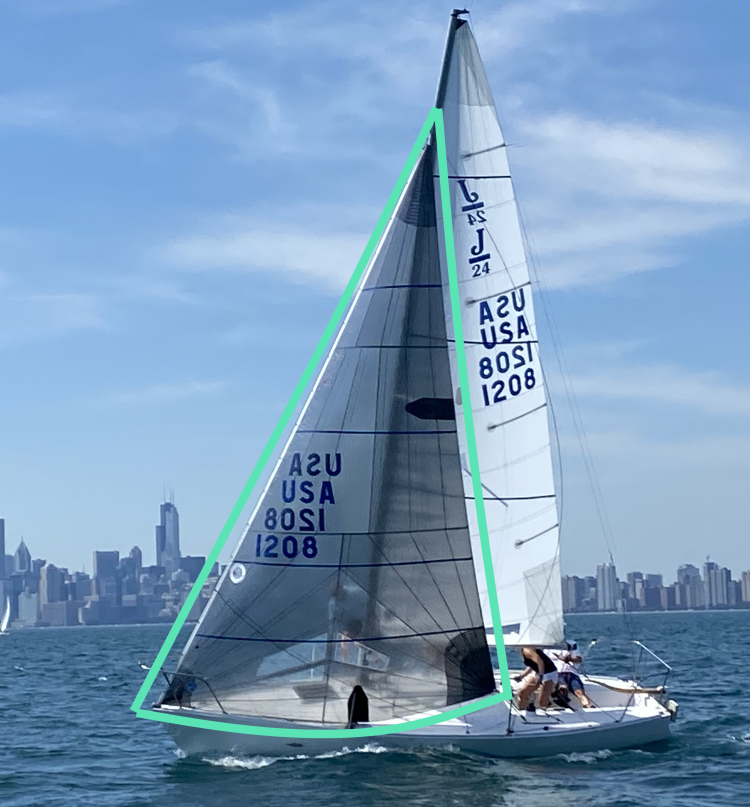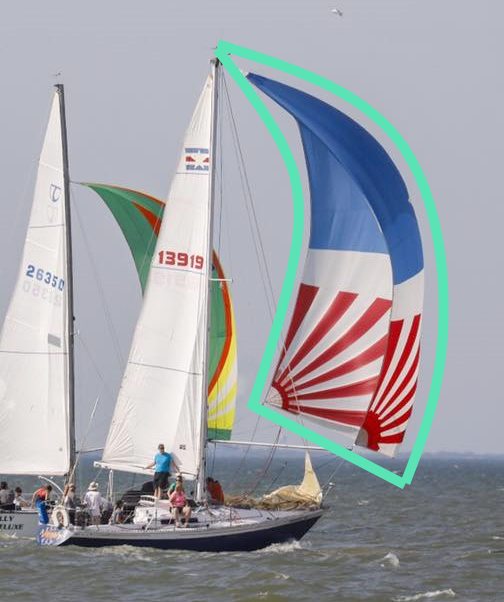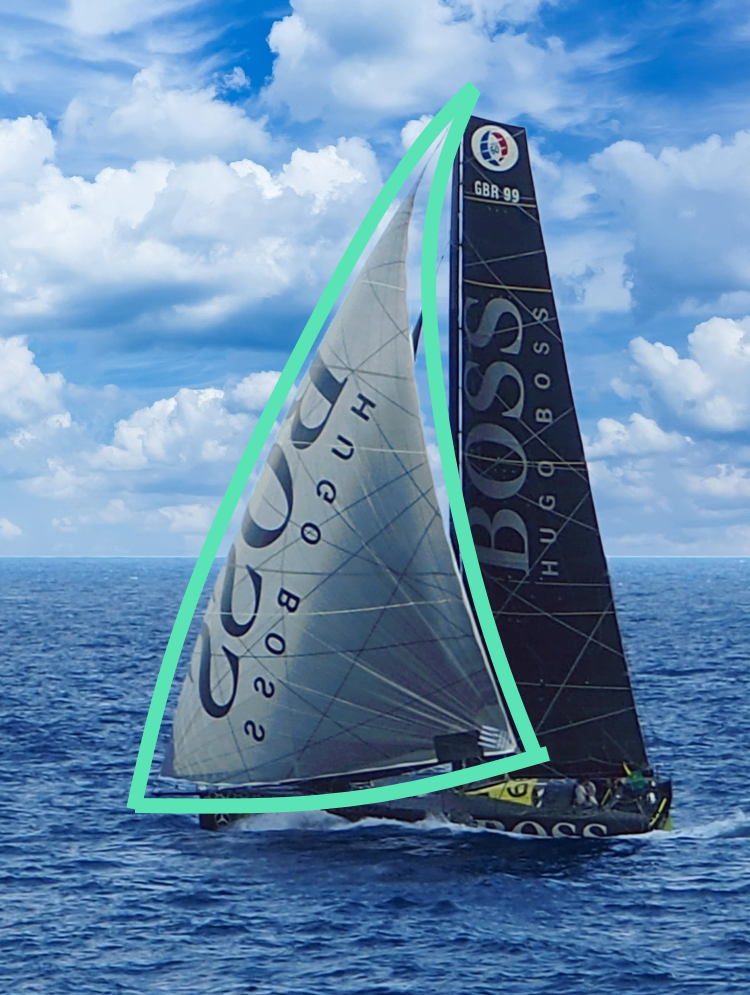When you’re new to sailing, there’s a ton of new terms and names that come at you. One of the most important terms you’ll hear are the names for sails. You want to know them, so when someone says “ease the jib” or “go get the code zero” you’ll have some idea what you’re supposed to do.
We use different sails for different wind conditions and directions. Your skipper will call for different sail combinations going upwind in heavy breeze than for downwind in light air. We’ll give you not only the names, but basic information about when you might expect to see these sails come out of the bag.
And while we’re at it, we’ll throw in a bunch of bonus names which are all related to sails, sail parts, and how they connect to the boat. Learn them if you can, but we’ll have another article on all those bits down the road. If it’s in bold, you’re probably going to need it someday.

Mainsail
The mainsail is used in all sailing conditions. It is a primary driver up upwind sailing, and is eased far to the side of the boat to catch breeze sailing downwind.
It is a triangular sail which attaches along its front edge (the luff) to the back of the boom. It is also attaches to a rope that pulls it up the mast (the main halyard), and at the back corner of the sail (the clew) to the outhaul, a line to pull in or ease the sail. Most mainsails don’t attach to the boom except at the front corner of the sail (the tack) and the clew, so the bottom side of the sail (the foot) is usually loose and is adjusted with the outhaul.
The mainsail is made from a stiff and heavy sailcloth, and cut to trim into a tight curve like an airplane wing.
Headsail
Headsails are upwind sails and usually provide the best driving force to sail the boat at wind angles higher than ninety degrees to the boat. You can fly them down wind and they will move the boat, but they are far less efficient than downwind sails.
These sails attach to a wire or rope (a stay, sometimes called a headstay or forestay) at the front of the boat, or the may furl around a tube at the bow. The jib halyard hauls up the rig, and the clew (aft corner) of the sail attaches to the control lines for the sail, known as the jib sheets. Headsails are often attached to the forestay with clips (hanks), though some systems use a groove system with a bolt rope on the luff of the sail which slides into a groove.
The jib sheet runs through a block and back to the cockpit for trimming and control. Headsails are made from stiff, heavy sailcloth and are cut for a wing-like trim.

Jib
A jib is a smaller headsail, generally near 100% of the size of the triangle made by the mast, the headstay, and the deck, known as the foretriangle. It won’t overlap any of the boat’s mast support wires (the shrouds), and can be swung cleanly through the foretriangle. This sail is for heavier wind conditions.
Genoa
The Genoa is simply an oversized jib. It is larger than the foretriangle area, and a Genoa is usually described by a percentage, such as a “130% Genoa” which refers to how far the Genoa overlaps the foretriangle.
They’ll also be described by numbers, for example, the #1, #2, and so on. The number one is the largest headsail on the boat, followed by the number two. A number three isn’t often much larger than a jib, but the 1/2/3 number designation isn’t an absolute description of the size of the sail, it’s only relative to the other sails in the inventory.

Staysail
A staysail is a headsail, because it attaches at the front of the boat…almost. A special inner forestay is used to run up the sail, and it has its own halyard. Not all boats have staysails, but they’re useful sailing upwind to slightly off the wind or reaching points of sail.
Spinnaker
Spinnakers are for mostly downwind sailing. They’re made of light nylon cloth, similar to parachute material. They’re cut into a much more rounded shape than upwind sails, since they’re used to catch the wind for pulling the boat rather than creating lift like an airplane wing.
Spinnakers are free flying sails, attaching at only three points at the corners, and not attached to any stay, and must be filled like a parachute for effectiveness.

Symmetrical Spinnaker
The symmetrical spinnaker has two sides of equal length, a head, and a foot. These sails are best sailing deep downwind, and they require a spinnaker pole. The sail attaches at the head to the spinnaker halyard, and at the corners of the sail to the spinnaker sheet and guy. There is no distinct tack and clew, nor is there a luff (or trailing edge or leech), since there is no front or back of the sail.
Since the symmetrical spinner is more complex to set and manage, it’s much more common racing and few cruisers mess around with them.
Asymmetrical Spinnaker
The sides of an asymmetrical spinnaker are different, which gives the sail a distinctive tack and luff at the end of the longer side, and a clew on the shorter edge. The sail hoists at the top with the halyard and the tack connects to an adjustable line at the bow of the boat (the tack line), usually on a short pole extending in front of the boat. Sheets run aft to control the sail.
Because of its shape, the asymmetrical doesn’t sail as deep down wind as the symmetrical, but it can give very good sailing speed sailing on higher angles. Boats with asymmetrical sails make up for losing downwind direction with the higher speeds.
Because of their easy handling, asymmetrical spinnakers have gained much favor with cruising sailors, with various snuffers and other devices to make shorthanded sailing even easier.


Code Sail
A Code Sail is a free flying sails ranging from something like a spinnaker in lightness to stiffer sails for more upwind performance in lighter breeze. Most cloth choices are closer to stiffer upwind sails than parachute cloth, though the cloth is lighter than headsails.
Because they are free flying, most of these sails aren’t left attached on the boat, though many of them have lightweight furling systems to hoist up for quick setting and dousing. These sails are very versatile, as they set and handle like spinnakers but give better upwind performance at close reaching angles.

